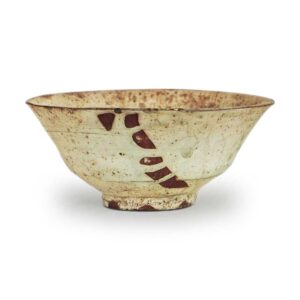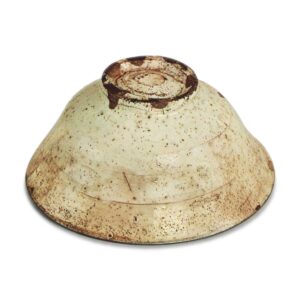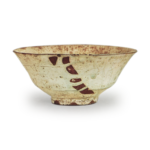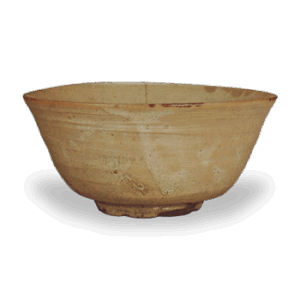

Height: 6.2-6.4cm
Diameter: 14.3-14.8cm
Height of foot ring: 5.6cm
Height of foot ring: 0.8cm
The name “Tsuda Kohiki” is derived from the fact that the three characters “Kohiki” are written on the back of the box lid, and it is said that they were written by Tsuda Sōyū. The calligraphy is certainly thought to be the handwriting of Soju, and it may even be a tea bowl that he owned. Although the author is unknown, it is also interesting that the accompanying note states that it is “better than Sobai”. The fact that the tea bowl is not compared to the Miyoshi Kohiki or the Matsudaira Kohiki owned by Fumai, but is contrasted with Sobai, shows the discernment of the author of the inscription. Of the four bowls of powder-glazed ware included in this book, the three by Miyoshi and Matsudaira are of the same type, and although the shape of the Chohaku and Tsuda bowls differ, the clay body, the texture of the clay, and the glaze are extremely similar, and it is thought that they were probably made in the same kiln at the same time. The author of the inscription says that it is “better than Chohaku”, but whether one is better than the other is a matter of personal taste. Those who feel that Chohaku has a deeper flavor in the shape it holds within, will say that Chohaku is better, while those who feel a sense of affinity with the sharp, angular style of this tea bowl will say that it is better. In addition, many people appreciate the vast style of the Miyoshi Kohiki and the unique beauty of the shape of the Koryo tea bowl, so there is no doubt that each of these three types of tea bowl is an outstanding masterpiece.
The distinctive feature of Tsuda Kohiki is that, unusually for a Koryo-style tea bowl, it has strong, sharp lines. The lines that show the clear traces of the scraping from the foot to the waist, where the bowl is knotted like a bamboo joint, and then the line that widens slightly towards the rim, are particularly beautiful. It is not exactly generous, but it has a flawless beauty. From the outside, it looks too symmetrical and a little thin, but the inside is not as sharply defined as the outside, and the rim gradually widens out from the center, again with a slight inward curve. When it was fired, it must have been as beautiful as a large white morning glory. What is most outstanding about this teacup is the so-called “fire marks” that are unique to kohiki teacups. Perhaps there is no other teacup that has such beautifully balanced overall shape and extraordinary fire marks. The clay is a dark brown with a high iron content, and the glaze has a bluish sheen. The stains that appear on the inside and outside add to the flavor, but some people may think that it would be even more beautiful and elegant without them.
The powdered glaze, which is usually called “Kaitakadai” in common parlance, has six distinct marks, and it has all the characteristics of a powdered glaze tea bowl. The powdered writing on the lid of the box is a copy of the three characters “Kofuki” written by Soetsu. It has been passed down in the Konoike family of Osaka, but it is not clear when it came into the Konoike family. The fact that the family crest of the Konoike family is “い貳” suggests that it was probably quite early, probably around the time of Michihiro. It is said that the family split off and moved to the branch family, and that this is recorded in the Konoike family’s memorandum.








